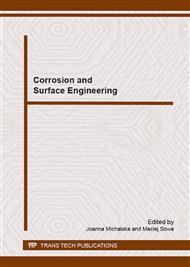p.243
p.247
p.251
p.255
p.259
p.263
p.267
p.271
p.275
Hydrogen Diffusion Characteristics in the TRIP 800 C-Mn-Si Steel
Abstract:
The presented paper is devoted to the study of hydrogen diffusion characteristics in the C-Mn-Si TRIP 800 steel. The steel was tested in three different states: in as-received state after hot and cold rolling and subsequent heat treatment; and furthermore after 5% and 10% tensile deformation. Hydrogen diffusion characteristics were studied by means of electrochemical permeation method. Two build up transients corresponding to lower and higher charging current densities as well as a decay transient were recorded during experiment. The lowest values of hydrogen diffusion coefficient (from 1 to 3.5.10-7 cm2.s-1) were observed during the first build up transient; the value of 3.5.10-7 cm2.s-1 corresponded to 10% tensile deformation. During the 2nd build up transient corresponding to the higher charging current density, hydrogen diffusion coefficients increased markedly reflecting thus the fact that hydrogen trapping was less pronounced. For decay transients hydrogen diffusion coefficients were situated between values obtained for the 1st and 2nd build up transients. In all studied states, a rather high sub-surface hydrogen concentration was observed during the 1st build up transient rising to 12.6 ppm of hydrogen in as-received state. The obtained results are explained taking into account steel microstructure and hydrogen trapping.
Info:
Periodical:
Pages:
259-262
Citation:
Online since:
January 2015
Authors:
Keywords:
Price:
Сopyright:
© 2015 Trans Tech Publications Ltd. All Rights Reserved
Share:
Citation:


